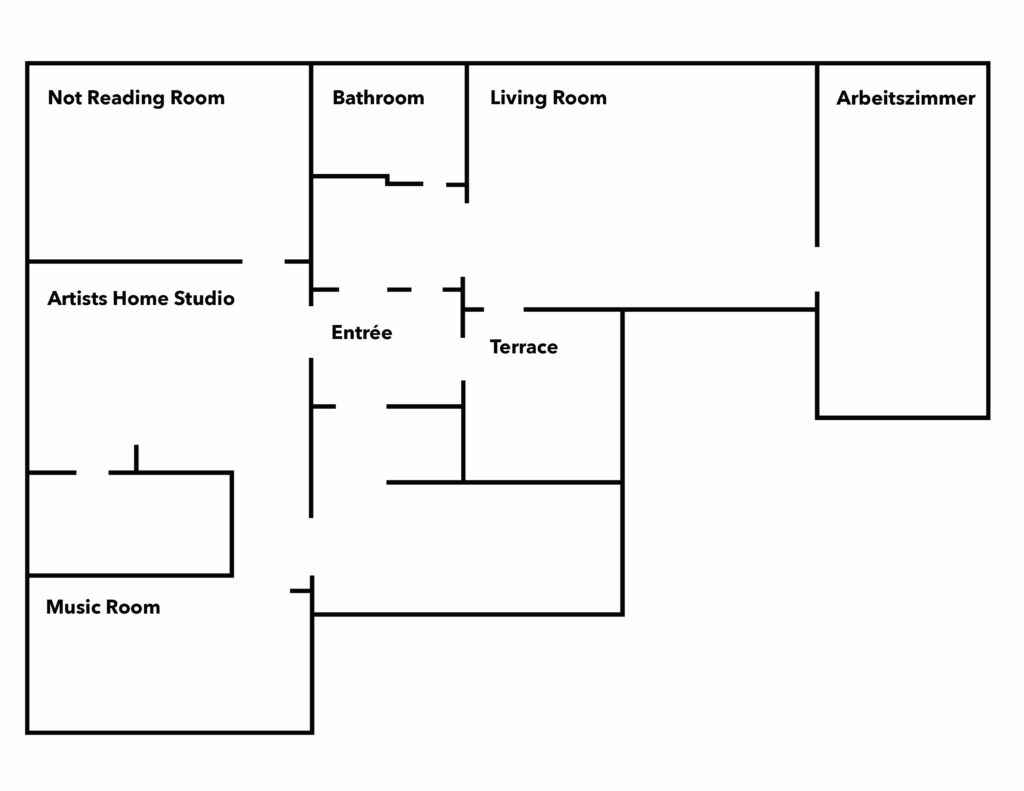Living Art
a pop-up exhibition
Art lives, even in challenging times. And we live with art. However, art requires space, to present itself, to enter a dialogue with the eye of the beholder. Space is scarce for art, not least in Munich, and even more so in times where access was first completely impossible during an unprecedented lock down of cultural life, and is even now only possible in a limited and regulated way. This motivates the decision to make private space available, first in October this year in the Munich Westend with this exhibition, and then in spring 2021 in a second exhibition in Gärtnerplatzviertel.
Living Art draws on the functional map of a space for living, true to the genius loci of a private apartment. A functional map that blends tradition of private living of an almost bygone era with the use case of a society in lock down and beyond, and which thus reaches back in history to project into the future. We are greeted in the Entrée with modern perspectives on the still life, from Karl Blossfeldt and Floris Neusüss over a pas de deux between Martin Klimas and Luzia Simons to Shintoinspired animated floral objects of Orié Inoué.
A suite of rooms in the northern part of the space begins with the Music Room, which is founded by two videos of Christoph Brech (DE), Opus 110a (Shostakovitch, with Christoph Poppen and the Münchner Kammerorchester and Nr. IV cis-moll A POP-UP EXHIBITION 5 (Mahler, with Mariss Jansons and the Symphonieorchester des Bayerischen Rundfunk). The installation of Matthias Deumlich, Spröde Flut, and Martin Klimas’ photographic Sonic Sculptures each address the dynamic, and Michael Wesely the time-based nature of sound and music in a visual translation. Charly-Ann Cobdak’s Tschaikowsky Kunstmaschine reminds us of the playful note of music, whereas the sound installation of James Webb transforms a piece of Messiaen itself.

The Artists’ Home Office showcases various artistic approaches to the lock down, with a common theme of focus in size, and a return of the sketch. Objects by Julia Haugeneder, Orié Inoue and Andrea V Wright, installations by Dalila Gonçalves and Oh Soek Kwon, and a collaboration with Rosa Stern Space with a multitude of drawings by 25 artists are reflections of the artists thrown on her- or himself.
The Library is actually the Not Reading Room, presenting a hermetic take on literature in translation by the visual arts. Fernanda Fragateiro’s La Fin du language, first shown in Germany, corresponds with Antonio Riello’s Ashes to Ashes (an approach to books that only a non-German artist could take) and James Webb’s two installations We are not in this world alone, we are in a thousand worlds, each bookended literally by Marila Dardot’s A pronúncia do mundo, while Azagdeh Razaghdoost’s and Rainer Pfnür’s paintings each take a calligraphic-gestural approach.
The Bath Room invites to emerge oneself in the multi-channel installation of Bianca Kennedy We are all in this together, or to contemplate over Thai Ho Pham’s Denkpause.
In the Living Room, we find Alex Verhaest’s multi-faceted and multi-dimensional take on art history, family live and video art including an inter-active video with Temps Mort, which is contrasted by Jacky Conolly’s slightly dystopian view on US American suburbia in the videos Hudson Valley Ruins and Anhedonia and Bianca Kennedy and The Swan Collective’s video Life between the walls. Pierre Jean Giloux’ four-channel video installation Invisible Cities broadens the perspective to past urban utopias and current realities in an aging population, whereas Gil Heitor Cortesão presents a modernist interior in an uncanny way, using behind-glass painting.
The Living Room is also the living heart of the exhibition and will feature live performances by Nicola Kötterl and Jakob Braito.
The exhibition concludes in the Arbeitszimmer, for which interestingly enough neither study nor office are adequate translations. Works from Verónica Vásquez, Dalila Gonçalves, Herbert Golser, Kristina Kanders, Holger Zimmermann and Julia Schrader not only reflect different artistic work practices, but at the same time canvass work and labour from handicraft to industrialization, as well as from different gender perspectives.
Stepping outside on the Terrace, with a view to the roofs around Gollierplatz, we muse over the encounter of Thomas Hörl’s irrevential sculptures with Dalila Gonçalves Kneaded Memories.
Munich, October 2020
Dr. Isabella Grahsl and Dr. Christian B. Fulda
